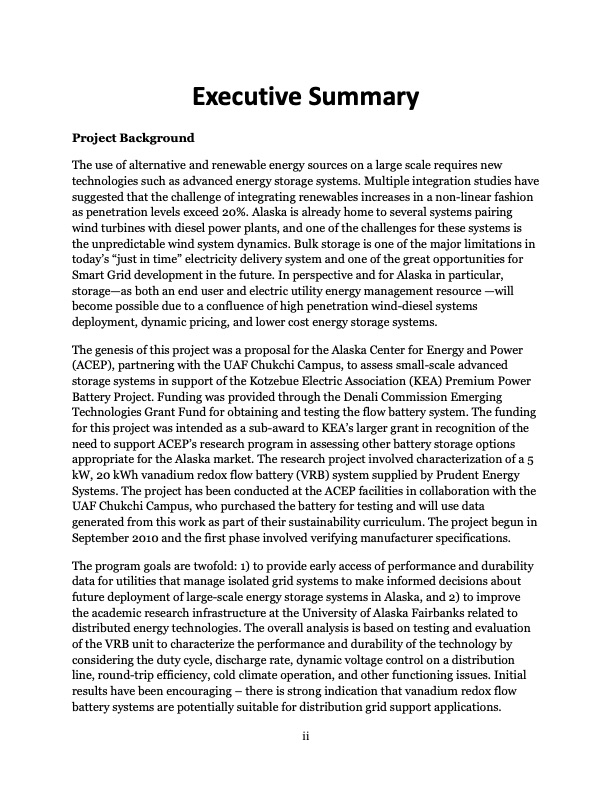
PDF Publication Title:
Text from PDF Page: 007
Executive Summary Project Background The use of alternative and renewable energy sources on a large scale requires new technologies such as advanced energy storage systems. Multiple integration studies have suggested that the challenge of integrating renewables increases in a non-linear fashion as penetration levels exceed 20%. Alaska is already home to several systems pairing wind turbines with diesel power plants, and one of the challenges for these systems is the unpredictable wind system dynamics. Bulk storage is one of the major limitations in today’s “just in time” electricity delivery system and one of the great opportunities for Smart Grid development in the future. In perspective and for Alaska in particular, storage—as both an end user and electric utility energy management resource —will become possible due to a confluence of high penetration wind-diesel systems deployment, dynamic pricing, and lower cost energy storage systems. The genesis of this project was a proposal for the Alaska Center for Energy and Power (ACEP), partnering with the UAF Chukchi Campus, to assess small-scale advanced storage systems in support of the Kotzebue Electric Association (KEA) Premium Power Battery Project. Funding was provided through the Denali Commission Emerging Technologies Grant Fund for obtaining and testing the flow battery system. The funding for this project was intended as a sub-award to KEA’s larger grant in recognition of the need to support ACEP’s research program in assessing other battery storage options appropriate for the Alaska market. The research project involved characterization of a 5 kW, 20 kWh vanadium redox flow battery (VRB) system supplied by Prudent Energy Systems. The project has been conducted at the ACEP facilities in collaboration with the UAF Chukchi Campus, who purchased the battery for testing and will use data generated from this work as part of their sustainability curriculum. The project begun in September 2010 and the first phase involved verifying manufacturer specifications. The program goals are twofold: 1) to provide early access of performance and durability data for utilities that manage isolated grid systems to make informed decisions about future deployment of large-scale energy storage systems in Alaska, and 2) to improve the academic research infrastructure at the University of Alaska Fairbanks related to distributed energy technologies. The overall analysis is based on testing and evaluation of the VRB unit to characterize the performance and durability of the technology by considering the duty cycle, discharge rate, dynamic voltage control on a distribution line, round-trip efficiency, cold climate operation, and other functioning issues. Initial results have been encouraging – there is strong indication that vanadium redox flow battery systems are potentially suitable for distribution grid support applications. iiPDF Image | Advanced Battery Storage Systems Testing at ACEP VRB ESS

PDF Search Title:
Advanced Battery Storage Systems Testing at ACEP VRB ESSOriginal File Name Searched:
ACEP-VRB-Testing-Report.pdfDIY PDF Search: Google It | Yahoo | Bing
Salgenx Redox Flow Battery Technology: Salt water flow battery technology with low cost and great energy density that can be used for power storage and thermal storage. Let us de-risk your production using our license. Our aqueous flow battery is less cost than Tesla Megapack and available faster. Redox flow battery. No membrane needed like with Vanadium, or Bromine. Salgenx flow battery
| CONTACT TEL: 608-238-6001 Email: greg@salgenx.com | RSS | AMP |